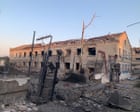
In the quiet of the early hours, a somber event unfolded in Ukraine, resonating deeply across its landscape and in global consciousness. Russian airstrikes marked one of the deadliest assaults in recent months, bringing renewed urgency to the dense tangle of international diplomacy seeking a path to peace. Ukrainian officials reported that at least 25 individuals lost their lives, and approximately 100 suffered injuries across multiple regions, painting a poignant picture of the continuing strife.
Among the most devastating occurrences was a missile strike on a prison facility in Bilenke, situated in the frontline region of Zaporizhzhia. The deadly attack claimed 17 lives and inflicted injuries on numerous others, underscoring the heightened risks civilians face amid ongoing conflict. This tragedy was felt most acutely just hours after former U.S. President Donald Trump proposed a deadline for diplomatic progress towards a ceasefire, suggesting a window of “10 or 12 days” for Russia to take meaningful steps towards peace or contend with further international sanctions.
President of Ukraine, Volodymyr Zelenskyy, provided a solemn update on the occurrences, emphasizing the scale of the loss. In the city of Kamianske, located within the Dnipropetrovsk region, a hospital was hit, resulting in the deaths of three individuals, tragically including a 23-year-old pregnant woman. These losses highlight the indiscriminate nature of the conflict and the heavy toll borne by civilians.
Amid these unfolding events, the international community stands in a delicate balance. On one hand, the calls for peace resonate strongly, echoing through diplomatic channels and public discourse. On the other, the path to cessation remains fraught with complexities, as geopolitical interests and on-ground realities intertwine. In the face of uncertainty, there is a shared recognition that meaningful dialogue and concerted diplomatic efforts are vital.
The implications of the former U.S. President’s statements were significant, suggesting a potential shift in the dynamics surrounding sanctions and international pressure on Moscow. This announcement followed a suite of dialogues aimed at fostering cooperative engagements that might yet unlock pathways to peace. Although the immediacy of the proposed deadline adds an element of urgency, it also offers a structured framework within which international stakeholders might find renewed impetus to act.
President Zelenskyy articulated a fervent appeal, not just to his nation but to the broader international stage, asserting that Russia’s actions challenge not only Ukraine and the European front but also the resilience of global peace and stability. His remarks echo a broader sentiment that the conflict’s resolution is tied deeply to international partnership and collective action.
At this juncture, mindful focus shifts to futures yet unwritten, where each diplomatic overture holds the potential to shape outcomes. The strategies ahead, though complex, reaffirm a commitment to finding pathways that prioritize peace and security. It is within the calm assessment and nuanced understanding of these realities that the international community may craft responses that hold promise for a more stable and harmonious future for Ukraine and beyond.
In conclusion, as the world watches and waits, the human dimension of these geopolitical maneuvers remains at the forefront. The resilience of the Ukrainian people and the sustained efforts of the international community continue to shine as beacons of hope in an otherwise tumultuous landscape. With careful consideration and collaborative action, there exists potential for transformation, guiding efforts to mitigate suffering and steering towards a resolution that honors peace and the shared humanity that binds us all.
Source: {link}
